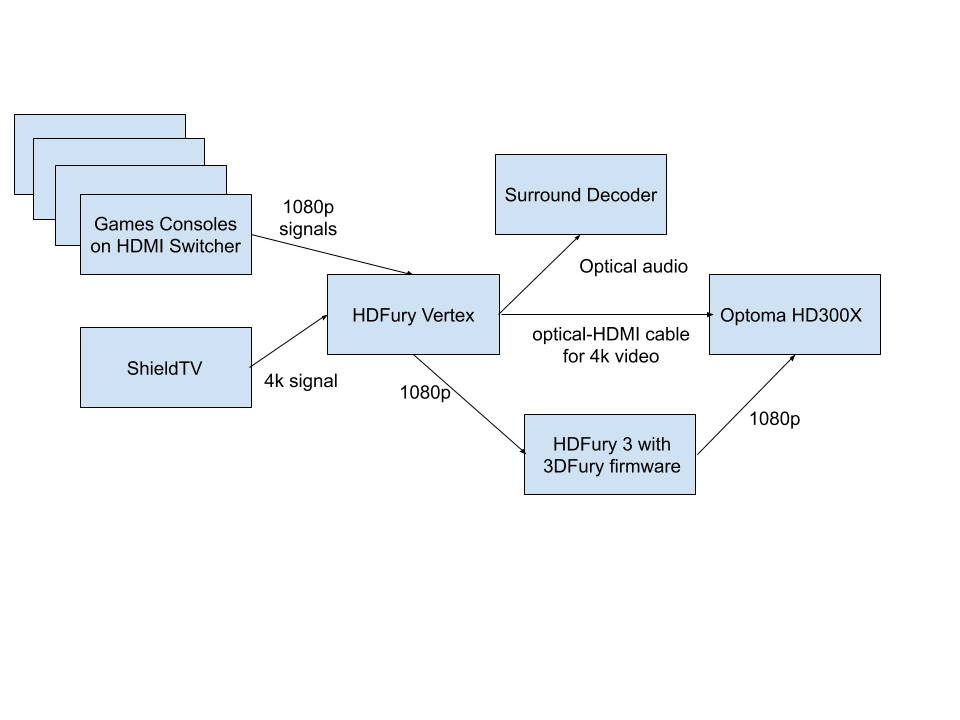I do have to admit, this was the third HDFury device I purchased, although the fourth I own. The others being the v1 (HDMI to VGA), v2 (Dual-HDMI to VGA) and the v3 (just for the 3DFury firmware to get a 3D signal into my Optoma projector that only supports 3D with 120 fps).
The main use case for me is as a buffer device between the ShieldTV and living-room home-cinema projector (Optoma HD300X), so that the ShieldTV always sees a 4k sink device and so chooses to give the best quality HDR image possible. Previously, this functionality was taken care of by a Yamaha A/V amp, but that’s not been terribly well since there was a leak in the roof that dripped through my bedroom floor down to the living room and onto the digital board in the amp…
But the HDFury Vertex is so much more than just a buffer.
According to the HDFury website, it’s a “It is a true 2×2 18Gbps HDMI matrix/splitter/switcher/scaler/converter/audio de-embedder, supporting any HDMI, any HDCP and any HDR up to HDR10+, HLG or Dolby Vision (including LLDV).”
Or in more normal words, you can connect anything to anything else via this device and you’ll get the best picture possible.
Basic control is via the device buttons with information displayed on the OLED screen (which you can disable for darker rooms), also via a serial port, but more advanced control requires the dedicated app and bluetooth module (“GoBlue” – not supplied) that attaches to the device via a mini-usb socket. With the app, you can adjust all of the settings on-the-fly, save profiles and see exactly what the device is doing. Which is handy if it’s stuck somewhere inaccessible. Or even if you are… 😉
The manufacturers spec’s are shown in the table below.
If all of this sounds like jibber-jabber, then you probably don’t need one… 😉
| HDMI revision: | HDMI 2.0b (Level A) 600Mcsc – 18Gbps |
| Vertex Support: | 600MHz/18Gbps HDR, HDR10+, HLG, DV & LLDV, ARC, ALLM, IMAX |
| Max Resolution: | 4K60 4:4:4 8b, 4K60 4:2:2 12b, 4K120 4:2:0 8b or 8K30 4:2:0 8b |
| I/O: | 2 HDMI In, 2 HDMI Out, IR, RS232, USB, Analog Jack, Optical Out. |
| Upscale port: | FHD 1080p to UHD 2160p & 4K/DCI |
| Downscale port: | UHD 2160p & 4K/DCI to FHD 1080p |
| Signal Conversion: | Resolution, Chroma Subsampling, Color Space, Color Depth, HDCP |
| HDCP Conversion: | Any HDCP to any HDCP with CST1 support |
| Operating Modes: | 18Gbps Scaler, Switcher, Splitter & Matrix with CEC, ARC and EDID management |
| Special Modes: | CEC Command, HTPC, Disable HDR, HDMI Doctor and JVC Macro. |
| EDID Modes: | 10 EDID Flags, 100 EDID Banks (10 custom) |
| Infoframe Modes: | Capture, edit, block or replace HDR metadata, AVI & VSIF.
Read SPD, Audio, HDMI Vendor, HDMI Forum |
| Control Modes: | IR, Windows GUI, RS232 for Linux/MAC/Win, Android/iOS with GoBlue |
| On Screen Display: | Editable with custom text and mask. (cover TV channel logo) |
| Oled Display: | 3.12″ Diagonal, 256×64, 16 green colors |
| Dimension: | 3.9″L x 2.4″W x 0.8″H – in CM: 10 x 6 x 3 |
| Weight: | 130g – 0.3 LBS |
| Other info: | Input Lag <1ms (nanoseconds count) |
For me, the HDFury Vertex is connected up like this

To be honest, not everyone will need something like this, but you’ll know if you do. Especially if you’ve ever had two HDMI devices refuse to play well together. In which case, this is exactly what you need!
Available from amazon.co.uk £237
Direct from hdfury.com $ 299 (plus import duties)